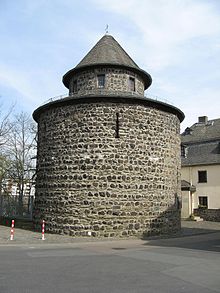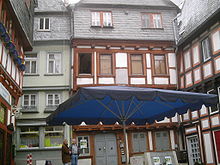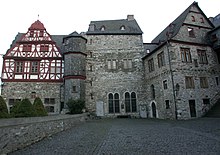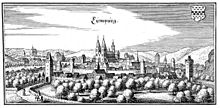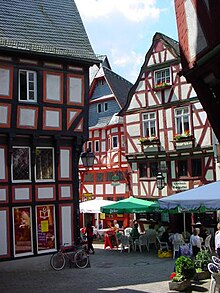Germany
Limburger Dom 1 in germany
Culture and Sightseeing
Theatre
The cabaret troupe “Thing”, founded more than 25 years ago, moved after a short time from its initial home in the outlying centre of Staffel to the Josef-Kohlmaier-Halle, a civic event hall, where its stage can now be found in the hall’s club rooms. The troupe is run by an independent acting club. On the programme are chanson, cabaret, literature and jazz as well as folk, rock and performances by singer-songwriters. It makes a point of furthering young artists. Each month, three or four events are staged.
The dedication of “Thing” was recognized on 6 December 2003 when the Kulturpreis Mittelhessen (“Middle Hesse Culture Prize”) was awarded to it.
Limburg Cathedral has a famous boys’ choir, the Limburger Domsingknaben, although they are actually based at the “Musical Boarding School” in Hadamar just outside Limburg.
Museums
In Limburg there are several museums. The most important are:
- Town of Limburg art collections that offer changing exhibits
- Staurothek, cathedral treasury and diocesan museum with the Limburger Staurothek (a cross reliquary)
- Museum Limburg Navy Museum
- Pallottine Mission museum
Buildings
Only a few towns, like Limburg, have been able to keep a full set of nearly unscathed mediaeval buildings. The formerly walled town core between St. George’s Cathedral, Grabenstraße (a street marking the old town moat) and the 600-year-old Lahn Bridge thus stands today as a whole under monumental protection.
The Altstadt ("Old Town") boasts a fine cathedral and is full of narrow streets with timber-frame houses, dating mainly from the 17th and 18th centuries. That's why it is located on the German Timber-Frame Road.
- Limburger Dom, one of the most complete creations of Late Romanesque architecture. It was printed on the reverse of the 1,000 Deutsche Mark note from the second series, which was in circulation from 1960 to 1989. The cathedral was recently renovated and painted to reflect its original appearance.
- Limburger Schloss, built in early 13th century by Gerlach von Ysenburg
- Burgmannenhaus, built about 1544; serves as a museum today
- St. Anna-Kirche (church), stained glass from third fourth of 14th century with eighteen scenes from the New Testament
- Old Lahn Bridge, from 1315, place where the Via Publica (road) crossed the Lahn
- In the Old Town stand many timber-frame houses from the 13th to 19th centuries. One peculiarity seen among the timber-framed houses of Limburg is the “hall house” from the High Middle Ages, which has a great hall on the ground floor. When restoration work began in the Old Town in 1972, the houses were carefully restored. Among the best known timber-frame houses are:
- Haus Kleine Rütsche 4, narrowest spot on the historic trade road between Frankfurt and Cologne, whose breadth is written at the Haymarket (Heumarkt) in Cologne
- Haus der sieben Laster (“House of the Seven Vices”) at Brückengasse 9, built in 1567, timber-frame house with carvings showing Christianity’s seven deadly sins, namely pride, greed, envy, lust, gluttony, wrath and sloth
- Werner-Senger-Haus, a beautiful stone hall house with timber-framed façade dating from the 13th century
- Houses at the fishmarket. The square’s name in the 13th century was still Fismart (“Yarn Market” or “Wool Market”) in the Limburg dialect, and it was the Limburg wool weavers’ trading centre
- Römer 2-4-6, Germany’s oldest freestanding house; in the garden a mikvah was found
- Rathaus (“Town Hall”), built in 1899
- “Huttig” (town wall tower remnant)
- Former noble estate of the Counts of Walderdorff at Fahrgasse 5
65549 Limburg an der Lahn:
Ausblick links vom Dom in germany Limburg an der Lahn (officially abbreviated Limburg a. d. Lahn) is the district seat of Limburg-Weilburg in Hesse, Germany.
Limburg lies in western Hesse between the Taunus and the
Westerwald on the river Lahn.
The town lies roughly centrally in a basin within the Rhenish Slate Mountains which is surrounded by the low ranges of the Taunus and Westerwald and called the Limburg Basin (Limburger Becken). Owing to the favourable soil and climate, the Limburg Basin stands as one of Hesse’s richest agricultural regions and moreover, with its convenient Lahn crossing, it has been of great importance to transport since the Middle Ages. Within the basin, the Lahn’s otherwise rather narrow lower valley broadens out noticeably, making Limburg’s mean elevation only 117 m above
Neighbouring communitiesLimburg forms, together with the town of Diez, a middle centre (in terms of
Central place theory) but partially functions as an upper centre to western Middle Hesse.
Limburg’s residential neighbourhoods reach beyond the town limits; the neighbouring centres of Elz and
Diez run seamlessly together.
Surrounding towns and communities are the community of Elz and the town of Hadamar in the north, the community of Beselich in the northeast, the town of Runkel in the east, the communities of Villmar and Brechen in the southeast, the community of Hünfelden in the south (all in Limburg-Weilburg), the community of Holzheim in the southwest, and the town of Diez and the communities of Aull and Gückingen in the west (all in the Rhein-Lahn-Kreis in
The nearest major cities are Wetzlar and Gießen to the north east, Wiesbaden and Frankfurt to the south and
Koblenz to the west.
History
About 800, the first castle buildings arose on the Limburg crags. This was probably designed for the protection of a ford over the river Lahn. In the decades that followed, the town developed under the castle’s protection. Limburg is first mentioned in documents in 910 under the name of Lintpurc when
Louis the Child granted Konrad Kurzbold an estate in the community on which he was to build a church. Konrad Kurzbold laid the foundation stone for Saint George’s Monastery Church, where he was also buried. The community soon increased in importance with the monastery’s founding and profited from the lively goods trade on the Via Publica.
In 1150, a wooden bridge was built across the Lahn. The long-distance road from Cologne to Frankfurt am Main subsequently ran through Limburg. In the early 13th century, Limburg Castle was built in its current form. Shortly afterwards, the town passed into the ownership of the Lords of Ysenburg. In 1214, the community was granted town rights. Remains of the fortification wall from the years 1130, 1230 and 1340 with a maxiumum length of roughly one thousand metres indicate to this day the blossoming town’s quick development in the Middle Ages. There is proof of a mint in Limburg in 1180.
One line of the Lords of Ysenburg resided from 1258 to 1406 at Limburg Castle and took their name from their seat, Limburg. From this line came the House of Limburg-Stirum and also Imagina of Isenburg-Limburg, German King
Adolf’s wife.
The ruling class among the mediaeval townsfolk were rich merchant families whose houses stood right near the castle tower and were surrounded by the first town wall once it was built. The area of today’s Rossmarkt (“Horse Market”), in which many simple craftsmen lived, was only brought within the fortifications once the second town wall was built. The inhabitants there, however, unlike the merchant élite, were accorded no entitlement to a voice in town affairs and were not allowed to send representatives to the town council. Nevertheless, they had to bear the main financial burden of running the town. Only in 1458 were they allowed to send two representatives to town council.
Saint George’s Cathedral (Sankt-Georgs-Dom) built on the old monastery church’s site, and also called Georgsdom, was consecrated in 1235. On 14 May 1289, a devastating fire wiped out great parts of the inner town, although these were subsequently rebuilt. One of the houses built at that time was the Römer 2-4-6, which is today one of Germany’s oldest half-timbered houses. In 1337, Limburg’s Jews were expelled from the town. Only in 1341 were they once again able to settle in the town, by royal decree. In 1344 a half share of the town was pledged to the Electorate of Trier, and in 1420, the town passed wholly into the ownership of Trier. This event, along with another town fire in 1342, the Black Death in 1349, 1356 and 1365, but above all the rise of the Territorial Princes, led to a gradual decline. In 1315 and 1346, the old stone Lahn Bridge was built (presumably in two sections).

Against the background of the German Peasants' War, unrest also arose among the townsfolk in 1525. After the Elector of Trier had demanded that the townsmen turn a
Lutheran preacher out of the town, a board made up of townsmen who were ineligible for council functions handed the council a 30-point comprehensive list of demands on 24 May. It dealt mainly with financial participation and equality in taxation, trade and building issues with the merchant class. In the days that followed, these demands were reduced in negotiations between the council and the board to 16 points, which were likely also taken up with the Elector afterwards. On 5 August, however, Archbishop Richard ordered the council to overturn all concessions to the townsmen. Furthermore, a ban on assembly was decreed, and the ineligible townsmen were stripped of their right to send two representatives to council.
In 1806, Limburg came into the possession of the newly founded Duchy of Nassau. In 1818 the town wall was torn down. In 1827 the town was raised to a Catholic episcopal seat. In 1866 the Duchy and with it Limburg passed to Prussia in the wake of the Austro-Prussian War. As of 1862, Limburg became a railway hub and from 1886 a district seat. In 1892, the Pallottines settled in town, but only the men; the women came in 1895.
During World War I there was a major prisoner of war camp at Limburg an der Lahn. Many Irish members of the British Army were interned there until the end of the war and at one stage they were visited by the Irish republican leader Roger Casement in an attempt to win recruits for the forthcoming
From 1919 to 1923, Limburg was the “capital” of a short-lived state called Free State Bottleneck (or Freistaat Flaschenhals in German) because it was the nearest unoccupied town to the Weimar Republic.

